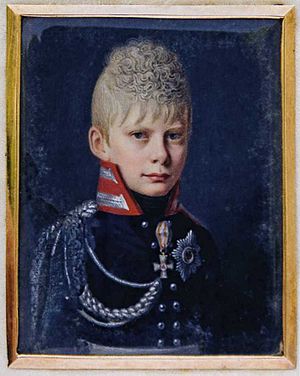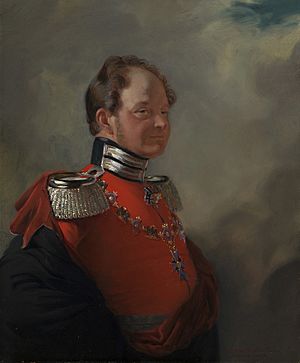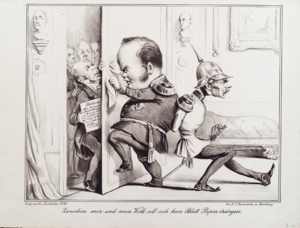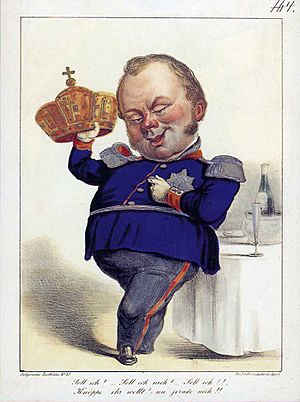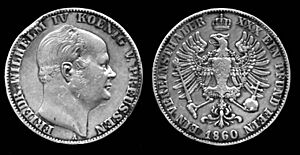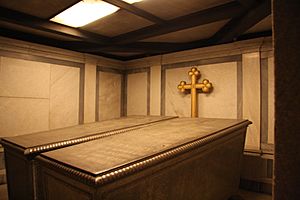Frederick William IV of Prussia facts for kids
Quick facts for kids Frederick William IV |
|
|---|---|
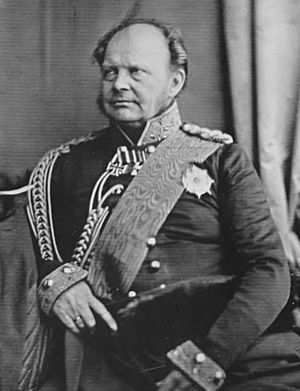
Frederick William IV in 1847
|
|
| King of Prussia | |
| Reign | 7 June 1840 – 2 January 1861 |
| Predecessor | Frederick William III |
| Successor | William I |
| Regent | Prince William (1858–1861) |
| President of the Erfurt Union | |
| Reign | 26 May 1849 – 29 November 1850 |
| Born | 15 October 1795 Kronprinzenpalais, Berlin, Kingdom of Prussia |
| Died | 2 January 1861 (aged 65) Sanssouci, Potsdam, Kingdom of Prussia |
| Burial | Crypt of the Friedenskirche, Sanssouci Park, Potsdam (Heart in the Mausoleum at Charlottenburg Palace, Berlin) |
| Spouse | Elisabeth Ludovika of Bavaria |
| House | Hohenzollern |
| Father | Frederick William III of Prussia |
| Mother | Louise of Mecklenburg-Strelitz |
| Religion | Calvinist (Prussian United) |
| Signature | |
Frederick William IV (German: Friedrich Wilhelm IV.) was the King of Prussia from 1840 to 1861. He was the oldest son of Frederick William III of Prussia. People often called him the "romanticist on the throne."
He is famous for building many beautiful structures in Berlin and Potsdam. He also helped finish the amazing Cologne Cathedral.
In politics, Frederick William IV was a conservative. This means he liked traditional ways of governing. He tried to make some changes, like easing rules on newspapers. He also worked to get along better with the Catholic people in his kingdom.
During the German revolutions of 1848–1849, he first tried to work with the revolutionaries. However, he refused to become "Emperor of the Germans." He believed the Parliament did not have the right to offer him this title. He later used his army to stop the revolutions across the German Confederation.
After 1849, he changed Prussia into a constitutional monarchy. This meant the king still ruled, but a constitution limited his power. He also gained the port of Wilhelmshaven in 1853.
From 1857, he suffered several strokes. This made him unable to rule. His brother, Wilhelm, became regent in 1858. Wilhelm then became king after Frederick William IV died in 1861.
Contents
Early Life and Interests
Frederick William was born on October 15, 1795. His parents were King Frederick William III and Queen Louise. He was his mother's favorite child.
He had private teachers, many of whom were experienced government workers. He also served in the Prussian Army during the war against Napoleon in 1814. Even though he was a soldier, he was not very interested in military life.
Frederick William loved drawing, architecture, and gardening. He supported many famous German artists. These included the architect Karl Friedrich Schinkel and the composer Felix Mendelssohn.
In 1823, he married Elisabeth Ludovika of Bavaria. She was Catholic, so there were many talks before their wedding. She later became a Lutheran. They had a happy marriage but no children.
Frederick William was a strong Romanticist. This movement in Germany looked back to the Middle Ages. This made him a conservative at a young age. In 1815, he tried to make sure that rich landowners would have the most power in a new constitution.
He did not want a single, unified German state. He believed Austria should rule over Germany. He was happy with the title "Grand General of the Realm."
Frederick William's Reign
Becoming King and Early Actions
Frederick William became King of Prussia in 1840 after his father died. He also became the ruler of Neuchâtel, which is now part of Switzerland.
In 1842, he gave his father's animal collection to the new Berlin Zoo. This zoo opened in 1844 and was the first of its kind in Germany.
He worked closely with architects on many building projects. These included the Alte Nationalgalerie and the Neues Museum in Berlin. He also built the Orangerieschloss in Potsdam. He helped rebuild Schloss Stolzenfels and Burg Hohenzollern.
Even though he was conservative, he was not a harsh ruler. He made his father's strict policies less severe. He eased rules on newspapers and promised a constitution. However, he did not want an elected assembly. He preferred to work with the nobility.
In 1847, he called a national assembly. It was not a truly representative group. It was a "United Diet" of provincial estates. This group could raise taxes and borrow money. But it could not meet regularly.
Frederick William was a devout Calvinist. But his romantic ideas led him to help settle a church conflict in Cologne. He released the imprisoned Archbishop of Cologne. He also supported the building of Cologne Cathedral. In 1844, he attended the celebrations for the cathedral's completion. He was the first King of Prussia to enter a Roman Catholic church.
In 1842, he created a special award for science and art. It was called the "Pour le Mérite for Sciences and Arts." This award is still given today.
The Revolutions of 1848
In March 1848, revolutions broke out in Prussia. These were part of bigger revolutions across Europe. The king first tried to stop them with his army. But on March 19, he pulled back his troops. He then seemed to support the movement.
He promised to unite Germany. He formed a liberal government and called a national assembly. He also ordered that a constitution be written. But once he felt more secure, he sent the army back into Berlin. In December, he closed the assembly.
He still wanted to unite Germany for a while. The Frankfurt Parliament offered him the crown of Germany on April 3, 1849. But he refused it. He famously said he would not accept a "crown from the gutter."
The King refused because he dreamed of bringing back the medieval Holy Roman Empire. This empire had smaller kingdoms under a Habsburg emperor. Frederick William believed only German princes could offer him the imperial crown. He felt the Frankfurt Parliament did not have the right to give it.
After the Frankfurt Parliament failed to include the Habsburgs, they looked to Prussia. Frederick William then thought about a union led by Prussia. This would unite all German states except those ruled by the Habsburgs. He tried to create the Erfurt Union. But he gave up this idea in 1850. This was because Austria and Russia opposed it. The German Confederation remained the main government for German Europe.
Later Years and Death
After the 1848 revolutions, Frederick William became more withdrawn. He surrounded himself with advisors who were very traditional. He created a new constitution for Prussia. This constitution set up a Parliament with two parts. There was an aristocratic upper house and an elected lower house.
The lower house was elected by people who paid taxes. But it used a three-tiered system. This meant richer people had more voting power. So, not everyone had an equal vote. The king still chose all his ministers. He also kept control of the civil service and the military.
This new system was more liberal than before 1848. But it was still conservative. The king, the nobility, and the military kept most of the power. This constitution lasted until 1918.
From July 14, 1857, the king suffered a series of strokes. These left him partly paralyzed and mentally unwell. His brother, William, became regent on October 7, 1858. William later became King William I.
On November 24, 1859, the king had another stroke. This left his left side paralyzed. He used a wheelchair after that. On January 2, 1861, he died at Sanssouci palace after another stroke.
Frederick William IV was buried with his wife in the crypt. This is under the Church of Peace in Sanssouci Park, Potsdam. His heart was buried separately with his parents at Charlottenburg Palace.
Religion
Frederick William IV was a Calvinist. He belonged to the Evangelical State Church of Prussia. This church brought together Reformed and Lutheran believers.
Honours and Awards
Frederick William IV received many awards from different countries. Some of these included:
- Order of the Black Eagle (Prussia)
- Iron Cross (Prussia)
- Order of St. Hubert (Bavaria)
- Order of the Elephant (Denmark)
- Legion of Honour (France)
- Order of St. Andrew (Russian Empire)
- Order of the Golden Fleece (Spain)
- Order of the Garter (United Kingdom)
Images for kids
-
With the imperial crown offered to him by the parliamentarians of the Frankfurt National Assembly in hand, Prussian king Frederick William IV decides whether or not to accept it by counting off the buttons on his jacket: "Should I take it? Should I not? Should I?! Buttons, you want me to! Well, that's exactly why I won't!!", circa 1849
See also
 In Spanish: Federico Guillermo IV de Prusia para niños
In Spanish: Federico Guillermo IV de Prusia para niños
- Equestrian statue of Frederick William IV


